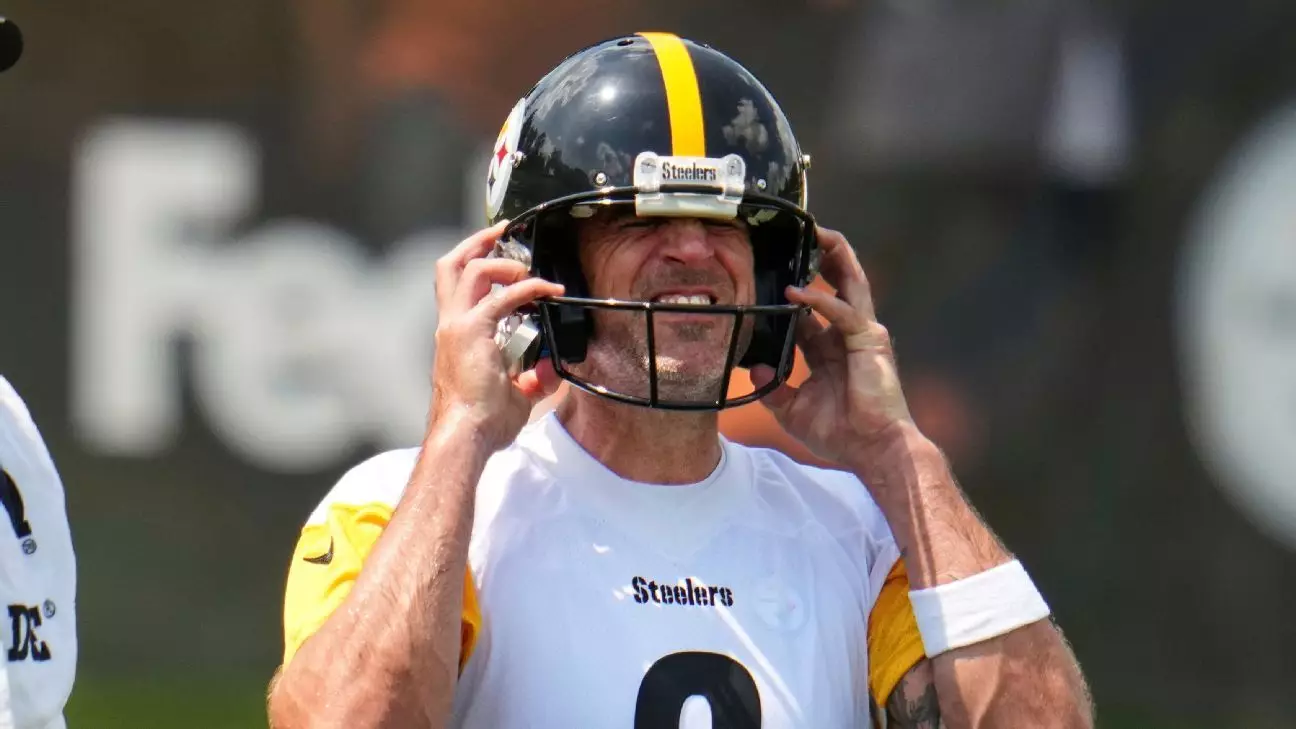In the world of professional sports, adaptability is often mistaken for compliance, but for athletes like Aaron Rodgers, it embodies the struggle of maintaining excellence amid relentless change. The recent helmet controversy exemplifies this tension. Rodgers, a veteran quarterback renowned for his precision and performance, finds himself at odds with the evolving safety standards that seemingly dictate his entire routine. His dissatisfaction with the new helmet, the Schutt Air XP Pro VTD II, isn’t merely about comfort—it’s a visceral reaction to losing a piece of his identity. The helmet, which he’s worn for years, symbolizes more than protection; it’s part of his physical signature on the field.
Rodgers’s candid frustration spotlights the often overlooked human element in sports innovation. While safety is paramount, the athlete’s comfort and familiarity directly influence confidence and performance. His candid remark, “It looks like a damn spaceship out there,” underscores a deeper resistance to change—the fear that modifications might impair his ability to perform at the highest level. This scenario is not unique to sports; it mirrors the broader human experience where change, even when necessary, can feel like an assault on personal identity and routine. Rodgers’s situation prompts us to reflect on how individuals cope with institutional shifts that threaten their sense of normalcy. His ongoing pursuit to find a suitable, safe, and comfortable helmet is emblematic of the importance of listening to the human element behind technological upgrades.
Furthermore, Rodgers’s public frustration serves as a reminder that athletes are not mere commodities but deeply human individuals with preferences and fears. His acknowledgment that “we’re trying to find the right helmet right now” reveals resilience—an acceptance that adaptation requires patience and persistence. It’s a lesson for organizations and teams to balance safety advancements with respect for tradition and individual needs. Ultimately, Rodgers’s challenge with his helmet encapsulates the universal struggle of navigating change while staying true to oneself.
Adversity on the Field: Overcoming Physical Setbacks with Mental Strength
While Rodgers battles with helmet discomfort, another story unfolds on the practice field—rookie quarterback Will Howard’s unforeseen injury. His “freak accident” during a routine exchange exemplifies how fragile physical health can be, even in highly controlled environments like professional training camps. Howard’s injury, a broken finger, illustrates a stark reality: in sports, even the smallest mistakes or unforeseen events can dramatically alter career trajectories. His initial belief that his injury was trivial reflects the common athlete’s mindset—often dismissing minor discomforts until they escalate.
Howard’s response demonstrates an impressive mental fortitude. Despite the injury, he displays a willingness to accept the setback, emphasizing his desire to stay prepared and ready to contribute when called upon. His words, “It sucks,” but “it’s about how you respond,” encapsulate a resilient attitude essential for any athlete aiming to succeed under pressure. The injury’s uncertainty—being “week-to-week”—adds an element of suspense, but Howard’s commitment to maintaining his fitness underscores the importance of mental toughness in overcoming physical adversity.
This episode carries broader implications. Athletes at all levels need to develop resilience that extends beyond their physical capabilities. Howard’s approach—staying engaged, being proactive about recovery, and maintaining a positive mental outlook—sets a valuable precedent. It reminds us that setbacks are inevitable, but how one responds defines the course of their career. His attitude reinforces an essential truth: adversity is not just a roadblock but an opportunity for growth and perseverance.
Leadership in the Shadow of Challenges
Amid these individual struggles, the leadership stance of coach Mike Tomlin provides a stabilizing influence. His reassurance regarding Rodgers’s injury—describing it as “nothing of any significance”—demonstrates confidence and calm in the face of potential chaos. Effective leaders in sports, much like in any domain, must manage not only physical resources but also morale. Tomlin’s words are strategic—aimed at reassuring teammates and fans alike that the team remains focused and resilient despite on-field disruptions.
Moreover, the dynamics among the quarterbacks—Rodgers’s veteran presence contrasted with Howard’s youthful potential—highlight a deeper organizational strength rooted in trust and stability. The team’s collective response to injuries, helmet frustrations, and adjustments illustrates the importance of a resilient leadership core that can inspire confidence even during turbulent times. It’s a testament to the culture cultivated within organizations where setbacks are acknowledged but never allowed to define the future.
Ultimately, these intertwined narratives expose the complex web of physical, mental, and strategic challenges that define modern sports. They reveal that resilience is not simply the absence of difficulty but the proactive, adaptive response to it. Athletes and coaches alike must confront their vulnerabilities openly, transforming setbacks into opportunities for growth and renewed focus. It is this relentless pursuit of excellence amid adversity that truly characterizes the spirit of champions.


Leave a Reply